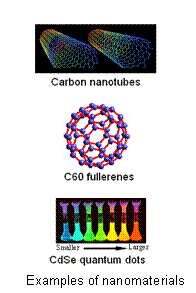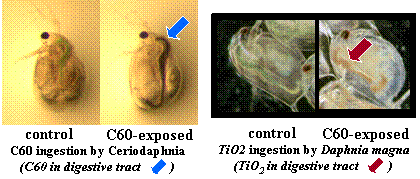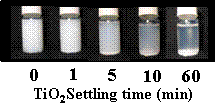Investigation of the Hazard and Potential Ecological Risk of Manufactured Nanomaterials
Project Summary

Nanotechnology is a rapidly expanding area of materials and chemical engineering that is expected to produce a wide range of new nanomaterials (materials that have at least one dimension between 1 and 100 nm). Manufactured nanomaterials are particulates, fibers, or agglomerates, have exponentially-increased surface area relative to bulk materials, and have physical/chemical characteristics strongly influenced by quantum mechanics rather than, or in addition to, the chemical properties historically used to characterize the toxicity of chemical stressors. These unique characteristics present challenges for regulatory testing programs within the EPA. For example, the test guidelines used by EPA and other regulatory agencies for chemical stressors are based on soluble rather than suspended substances. In addition, organism responses to exposure are currently quantified based on concentrations. In contrast, nanomaterial exposures will primarily involve particle suspensions that will require new approaches for quantifying organism response based on characteristics such as particle count and size (including size distribution), surface area, and other characteristics. Nanomaterials research at MED will address these challenges by focusing on the following:
- Developing nanomaterial suspension methods for aquatic toxicity testing.
- Developing methods for quantifying and characterizing concentration, particle size distribution, stability, and other properties of nanomaterial suspensions used in toxicity testing.
- Determining how variables such as mixing rate, ionic strength of media, exposure to light, and dissolved organic material affect the behavior and toxicity of nanomaterial suspensions.
- Assessing the toxicity of nanomaterials to aquatic species (both water-column and benthic) and investigating how preparation method and potentially mitigating factors effects levels of toxicity.

Key products
The nanotechnology research effort is in its early stages. However, as part of the planning process, MED researchers have been authors on several EPA, ORD, and MED planning documents. Dr. Steve Diamond has also chaired section groups within the Organization for Economic and Cooperative Development's (OECD) Working Party on Manufactured Nanomaterials, one of which has produced a draft summary report. The OECD report will also be presented as a platform presentation at the 2008 Annual Meeting of the Society for Environmental Chemistry and Toxicology.
Ma, H., A. Brennan, and S.A. Diamond. Phototoxicity of TiO2 nanoparticles under solar radiation to two aquatic species: Daphnia magna and Japanese Medaka. Environmental Toxicology & Chemistry, in press.
Ma, H., P.L. Williams, and S.A. Diamond. Ecotoxicity of manufactured ZnO nanoparticles--A review of in vivo data. Environmental Pollution, in press.
Nowack, B., J.F. Ranville, S. Diamond, J.A. Gallego-Urrea, C. Metcalfe, J. Rose, N. Horne, A.A. Koelmans, and S.J. Klaine. Potential scenarios for nanomaterial release and subsequent alteration in the environment. Environmental Toxicology and Chemistry, in press.
Aust, A.E., P.M. Cook, and R.F. Dodson. Morphological and chemical mechanisms of elongated mineral particle toxicities. Journal of Toxicology and Environmental Health, Part B: Critical Reviews.
Planning and review documents:
Draft Nanomaterial Research Strategy (EPA/600/S–08/002)
Exploratory Research Plan: Investigation of the Hazard and Potential Ecological Risk of Manufactured Nanomaterials
Report from SG4-2: Review of OECD Ecotoxicity Test Guidelines for their Applicability to Manufactured Nanomaterials.

Presentations:
Ma, H., A. Brennan, and S.A. Diamond. Phototoxicity of TiO2 nanoparticles to two aquatic species: Daphnia magna and Zebrafish (Danio rerio) embryo. International Conference on Environmental Pollution and Public Health, Shanghai, China, May 17- 20, 2012.
Diamond, S.A. The role of sunlight in assessing environmental risk of nanoscale titania. Duke University, Chapel Hill, NC, October 28, 2011.
Diamond, S.A., H. Ma, A.A. Brennan, and J.D. Fernandez. Phototoxicity and dosimetry of nano-scale titanium dioxide in aquatic organisms. Canadian Society of Chemistry’s 94th Canadian Chemistry Conference and Exhibition, Montreal, QC, June 5- 9, 2011.
Diamond, S.A. , A. Brennan, and J.D. Fernandez. Phototoxicity and dosimetry of nano-scale titanium dioxide in aquatic organisms. SETAC North America 31st Annual Meeting, Portland, OR, November 7-11, 2010.
Hoheisel, S., A. Brennan, S.A. Diamond, and D.R. Mount. Effects of nanosilver on Daphnia magna and Pimephales promelas. SETAC North America 31st Annual Meeting, Portland, OR, November 7-11, 2010.
Diamond, S.A. Assessing the environmental safety of engineered nanomaterials. Workshop on Nanoscale Science, Technology and Innovation, Rio de Janeiro, Brazil, September 28-30, 2010.
Diamond, S.A. 2008. U.S. Environmental Protection Agency nanoparticle research needs. MidSouth SETAC Regional Chapter Annual Meeting, 14-16 May 14-16, Vicksburg, MS.
Diamond, S.A., C. Andersen, S. Hirano, M.G. Johnson, D.R. Mount, P. Pandard, P. Rygiewicz, J.J. Scott-Fordsmand, K. Stewart. 2008. An evaluation of regulatory ecotoxicity test guidelines: Their adequacy for nanomaterials. The Society of Environmental Toxicology and Chemistry 29th Annual Meeting, 5-9, Tampa, FL.
Kennedy, A.J., S.A. Diamond, J. Goss, J. Steevens, J. Gunter, M. Hull. 2008. Assessing the implications of modified nanomaterials in bioassay testing. The Society of Environmental Toxicology and Chemistry 29th Annual Meeting, 5-9, Tampa, FL.
Diamond, S.A. 2007. Ecotoxicology of nanomaterials. 22nd Annual EPA Risk Assessors Conference, July 9-12, Brooklyn, NY.Project personnel
| Name | Phone | |
| Steve Diamond | diamond.steve@epa.gov | 218-529-5209 |
| David Mount | mount.david@epa.gov | 218-529-5157 |
| Dale Hoff | hoff.dale@epa.gov | 218-529-5386 |
Research project update date
January 26, 2011
![[logo] US EPA](../gif/logo_epaseal.gif)